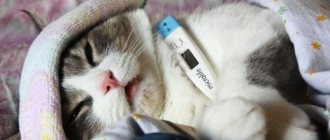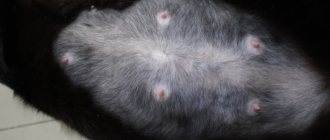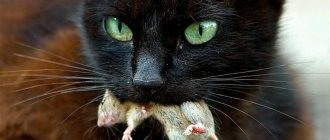Veterinarians strongly recommend sterilizing all pets not involved in breeding the breed. Taking hormonal drugs and regular empty estrus can result in much more serious problems than the anesthesia required for the operation.
One of the possible complications of rash refusal to sterilize is pyometra in a cat. Every owner should know what it is, since a late detected disease turns out to be fatal.
What is hidden under the word "pyometra"
Pyometra in a cat, or purulent endometritis, is an inflammatory process inside the uterus. Its main danger is the abundant formation of pus.
The accumulating exudate puts pressure on the internal walls and breaks them over time. Tissue damage leads to acute intoxication of adjacent parts of the abdominal cavity. The affected organs gradually lose their functionality, so the animal, left without timely help, dies.
How is the diagnosis made?
Making a diagnosis of “pyometra” is not difficult in classic cases based on history, examination, and physical examination, but there are also difficult cases with an atypical picture of the disease.
To make a diagnosis, the cat will need to be examined: blood tests, an ultrasound examination of the abdominal cavity, and an x-ray may be required.
A clinical blood test usually shows a high number of immune cells: leukocytes, monocytes, neutrophils and anemia; a biochemical blood test indicates kidney damage.
An X-ray examination can show the size of the cat's uterus, and an ultrasound can also help detect fluid in the organ cavity. If research data is available, the diagnosis will be final and reliable. Additional diagnostics are almost never required.
Main causes of the disease
The main cause of pyometra in cats is a malfunction of the reproductive organs. It occurs when the following factors are present:
- False pregnancies, difficult childbirth, vaginitis, cysts and other neoplasms. In these cases, purulent endometritis is secondary and develops as a complication.
- Regular use of hormonal medications. Contraceptives used by owners to prevent unwanted pregnancy alter natural hormone levels. As a result, the cyclicity of estrus deviates from the norm, provoking inflammation and oncology.
- A sharp jump in progesterone that occurs after each ovulation. Leads to thickening of the uterine mucosa (endometrium) and a decrease in immunity. The passage of cervical mucus becomes difficult. It accumulates inside and forms pathogenic microflora.
- Bacterial infection acquired during estrus. During this period, the body is very vulnerable, so the animal may become ill due to insufficient hygiene or as a result of infection by a sick mating partner. Also, bacteria can enter the uterus not directly, but through neighboring organs: the intestines or bladder.
Most often, unsterilized animals over 5 years old become ill. The likelihood of developing pathology increases when the recommended frequency of matings is violated and during empty estrus.
If you are overweight or have a too poor diet characterized by a lack of vitamins, even a very young animal can get sick. The only way to avoid this pathology is total removal of the reproductive organs.
Prevention
If the animal does not have breeding value, then the most effective method of prevention is sterilization or ovariohysterectomy. When performed at the age of 5-6 months, this operation not only prevents pyometra, but also reduces the likelihood of breast tumors in the future by 70-80%. Animals used for breeding should be monitored by qualified veterinarians to eliminate the risk of incorrect obstetric care and infection in the birth canal. Remember that you cannot breed cats with cats that are not vaccinated and have not undergone a preliminary veterinary examination. It is strictly not advisable to use drugs that suppress estrus. In the postpartum period, it is necessary to monitor the involution of the uterus using ultrasound. Also, do not forget about the symptoms of the disease, and if at least one of them appears, you should consult a doctor for advice.
Symptoms: discharge and other signs
In cats with pyometra, pus from inside the uterus leaks out through the vulva or remains inside. In the first case, the disease is called open. This form is accompanied by the appearance of unpleasant-smelling discharge. Their color and consistency are very diverse, but always deviate from the norm.
The second form of pathology is called closed. It is much more dangerous than the first one, since at an early stage its symptoms are very difficult to detect. Changes noticeable to the owner occur much later, when the endometrial walls become very thin under the pressure of the exudate. At this point, the condition is complicated by the following symptoms:
- acute pain on palpation of the abdomen;
- convulsions and muscle spasms that impair coordination;
- false urge to urinate;
- diarrhea, vomiting and temperature fluctuations (deviation from the norm both up and down).
You should not focus only on these symptoms, as well as the flaky consistency of unusually green or gray discharge. In this case, you may simply not have time to help your pet.
It is much more reliable to start from behavioral changes that occur soon after the onset of the inflammatory process. These include unusual apathy, lethargy, poor appetite and increased thirst.
Also added to these symptoms is a gradual enlargement of the abdomen. If you are not sure about pregnancy, be sure to have your pet checked by a veterinarian.
Risk factors
The disease can occur in dogs and cats of different ages. Older pets are most often affected by the disease, but it can also occur in very young animals. At risk are unsterilized individuals with a long, unsuccessful sexual cycle (in the absence of pregnancy).
Also, the cause of pyometra can be a hereditary predisposition to the disease, contact with sick individuals (the infection is transmitted through blood, during operations or childbirth, sexual intercourse), taking various medications not under the supervision of a veterinarian (including medications that suppress estrus, contraceptives) , immune system disorders, unsuccessful pregnancy, as well as some other diseases of the reproductive system.
Danger and complications
The main danger of the disease is death from acute peritonitis. It occurs when the endometrium ruptures, causing the entire abdominal cavity to fill with pus.
Another possible complication is falling into a coma due to dehydration. In this case, the body is severely depleted, so the likelihood of recovery is minimal. Most often, the animal dies without regaining consciousness.
Symptoms
The symptoms of this disease are not always associated specifically with the reproductive system: they affect the entire body. The disease has two forms: closed and open. In the first form, the cervix is closed and pus accumulates inside; in the second, part of it is expelled.
Since cats like to lick themselves frequently, it is quite difficult to identify the open form of the disease, while the symptoms of the closed form soon begin to bother the owners of the animal, because it manifests itself much more actively.
Signs of a closed form of pyometra are:
- Slight increase in the pet's belly;
- Constantly dry coat;
- Frequent urination and constant thirst;
- Lethargy, loss of appetite, vomiting;
- Purulent discharge from the uterus between estrus.
In the open form of the disease, the cat will remain active for a long time and will not change its behavior. Only discharge from the uterus with an unpleasant odor is noted. The discharge will be noticeable in the places where the cat sat, as well as on its fur and skin.
Carrying out diagnostics in the clinic
Diagnosis of pyometra in cats should be carried out strictly in a veterinary clinic. Otherwise, you risk damaging the endometrial walls while palpating the rounded abdomen.
Palpation alone is not enough to confirm the diagnosis. Other required studies include:
- biochemistry and general blood test;
- cytology of scrapings from the cervical canal;
- ECG, X-ray and ultrasound of the pelvis.
Based on the results obtained, not only the presence, but also the amount of exudate is determined. Based on this information, one of two methods is used to treat a mustachioed patient: medication or surgery.
Drug treatment method
In 85% of cases, medication is ineffective. For this reason, the main treatment method is surgery. It is recommended even for breeding animals, since after improvement in health there is still a high probability of relapse. In this case, kittens may be born with congenital abnormalities.
To carry out drug therapy, your pet must have a strong immune system and good health. The antibiotics and hormonal drugs used weaken the body's defenses and stimulate uterine contractions. All this is fraught with:
- miscarriages and abnormal development of fetuses;
- endometrial rupture and peritonitis;
- exacerbation of chronic pathologies;
- infertility;
- re-development of inflammation upon the onset of a new estrus or shortly after it.
It is much safer to operate on the animal immediately after diagnosis. Otherwise, the body, weakened by the disease, simply will not survive anesthesia during the next relapse, and all the efforts of the surgeon will be useless.
When surgery cannot be avoided
If a cat is diagnosed with closed pyometra, then surgery is mandatory. Other indications for emergency surgery include neoplasms and uterine rupture.
The operation involves removing not only the uterus, but also both ovaries, which completely eliminates relapses. When performing it, the laparoscopic method is increasingly used, which does not require large incisions and is limited to the application of intradermal sutures.
Carrying out the intervention
The procedure for removing reproductive organs is similar to conventional castration, but carries much more risks. This is due to purulent exudate, complicating the surgeon’s work.
If there is too much of it, the endometrium may rupture during surgery. For this reason, the animal is prescribed hormonal drugs that reduce internal pressure due to the partial removal of pus.
Other complications include internal bleeding and negative reactions to surgical sutures. In the latter case, the operation must be repeated.
You should not be afraid of the listed risks, since the consequences of the pathology itself are much more serious.
The same applies to general anesthesia. The dosage is selected individually for each patient, excluding a negative reaction to the administered drugs.
Recovery period: care and nutrition
After the pyometra is removed, a special bandage is put on the cat to protect the sutures from damage. The recovery period takes about 10-20 days, but the first improvements are noticeable already on the 2nd day. Until this point you need to:
- Maintain a fasting diet for 24 hours so as not to provoke vomiting.
- Smoothly switch to a gentle diet after the appearance of appetite. When feeding naturally, all foods should be ground or cut into small pieces. When dry feeding, wet canned food and granulated food for sterilized animals are suitable.
- Monitor the amount of fluid you consume to prevent dehydration.
- Provide a comfortable and warm place on the floor. Due to lack of coordination, jumping on high surfaces can result in injury.
Taking symptomatic medications and antibiotics is discussed individually. The same applies to seam care. Most ointments slow down tissue regeneration, so most often it is enough to prevent contamination of the postoperative wound and monitor its condition. If the stitches come apart, pus, blood or inflammation appears, it is recommended to contact a veterinary clinic.
Postoperative care
Having learned what pyometra is, what the symptoms and treatment are, you need to understand what postoperative care the animal requires. The pet’s recovery depends on the severity of the disease, the age and state of immunity of the four-legged friend, the presence of complications and other “layered” diseases. Most often, care consists of treating sutures, administering antibiotics (preferably intramuscularly), and also diet.
Remember that after removal of the uterus, your pet is considered sterilized. This means that she should eat accordingly, as befits sterilized animals. To prevent the female from tearing the stitches, take care of a postoperative blanket or a special collar that will not allow her to reach the wound.
If you notice ichor or pus flowing from the wound, severely swollen and hardened edges, or pain, you should immediately contact a veterinarian to avoid postoperative complications.










